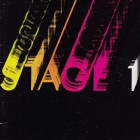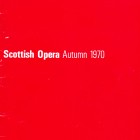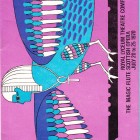Zauberflöte 1970Scottish Opera
Read more about the opera Magic Flute
In the summer of 1970, the Commonwealth Games were held in Edinburgh, the first time they had been staged in Scotland. Among the cultural celebrations mounted concurrently, Scottish Opera put on a new production of The Magic Flute. That the company had not staged the Flute previously may seem surprising, but in the sixties it was brought north several times by Sadler's Wells, and German productions had been brought to Edinburgh regularly during the Festival.
Nor had the company used the Lyceum before - an attractively intimate late Victorian theatre, that had been the city's base for Carl Rosa and Moody-Manners in Victorian and Edwardian times. It proved ideal for Mozart, and would be visited by the company every summer for several years to come. The designs were by the Lyceum's resident team, who were therefore accustomed to the unmodernised backstage equipment. Perhaps the larger than usual budget led them to overcomplicate things, and the designs, though attractive, suffered from the inherent clumsiness that became evident during the many scene changes.
Peter Ebert's production was a colourful affair which emphasised the multicultural elements of the plot. Only Papageno and spouse were costumed traditionally. Tamino's outfit showed a Tibetan influence; Sarastro and the priests were oriental in style; Monostatos and his men had a decidedly Arabian or Turkish appearance. Pamina wore a diamanté encrusted trouser suit in shocking pink. The still traditional blacking up of Monostatos looked odd when Sarastro was played by Simon Estes, an elegant young African-American making his local debut several years before he was recruited to sing the Dutchman at Bayreuth.
The Queen of the Night's blue costume had Tudor elements with blue make-up applied to her face. The three ladies were colour-coded - one green, one magenta, one yellow, with facial make-up matching the costumes. The three boys were little green men who looked exotic, evoking magical associations.
After the Games and the Edinburgh Festival, where the company played Elegy for Young Lovers, this joined the autumn tour, along with the Henze and Fidelio from the spring season. It also had a further run at the Lyceum in rep with Traviata and the English Opera Group King Arthur in December before joining the 1971 spring tour.
As with The Gondoliers, James Loughran brought his own band, the BBC Scottish Symphony Orchestra. Loughran himself conducted the Verdi, with his assistant, Christopher Seaman, taking some of the Mozart performances.
The schedule for this short December season was:
Edinburgh, Royal Lyceum Theatre: Fri Dec 11 Magic Flute; Sat 12 Traviata; Sun 13 -; Mon 14 King Arthur; Tue 15 Traviata; Wed 16 Magic Flute; Thu 17 King Arthur; Fri 18 Traviata; Sat 19 mat Magic Flute; Sat 19 eve King Arthur.
Performance Cast
- Tamino a Prince
- First Lady in attendance on the Queen
- Second Lady in attendance on the Queen
- Third Lady in attendance on the Queen
- Papageno a bird-catcher
- Queen of Night
-
Rhonda Bruce (Jul; Sep)
Jessica Cash (Dec)
- Pamina daughter of the Queen of Night
-
Jill Gomez (Jul; Sep)
Elizabeth Robson (Dec)
- Monostatos a servant in the Temple
- First Boy
- Second Boy
- Third Boy
- Speaker at the Temple
- Sarastro High Priest of Isis and Osiris
-
Simon Estes (Jul; Sep)
Stafford Dean (Dec)
- First Priest
- Second Priest
- Papagena disguised as an old woman
-
Nan Christie (Jul; Sep)
Laureen Livingstone (Dec)
- First Armed Man
- Second Armed Man
Production Cast
- Conductor
-
Alexander Gibson (Jul 20, 21, 24, 25; Sep 17, 22; Dec 11, 16)
Christopher Seaman (Jul 22, 23; Sep 19, 25; Dec 19)
- Director
- Designer - Sets
- Designer - Costumes
- Lighting
- Chorus
- Orchestra
- Translator
Performance DatesZauberflöte 1970
Royal Lyceum Theatre | Edinburgh
20 Jul, 19.30 21 Jul, 19.30 22 Jul, 19.30 23 Jul, 19.30 24 Jul, 19.30 25 Jul, 19.30 11 Dec, 19.30 16 Dec, 19.30 19 Dec, 14.30
King's Theatre, Glasgow | Glasgow
17 Sep, 19.30 19 Sep, 19.30
His Majesty's Theatre, Aberdeen | Aberdeen
22 Sep, 19.30 25 Sep, 19.30
Theatre Royal, Newcastle | Newcastle-upon-Tyne
16 Oct, 19.30 17 Oct, 19.30


